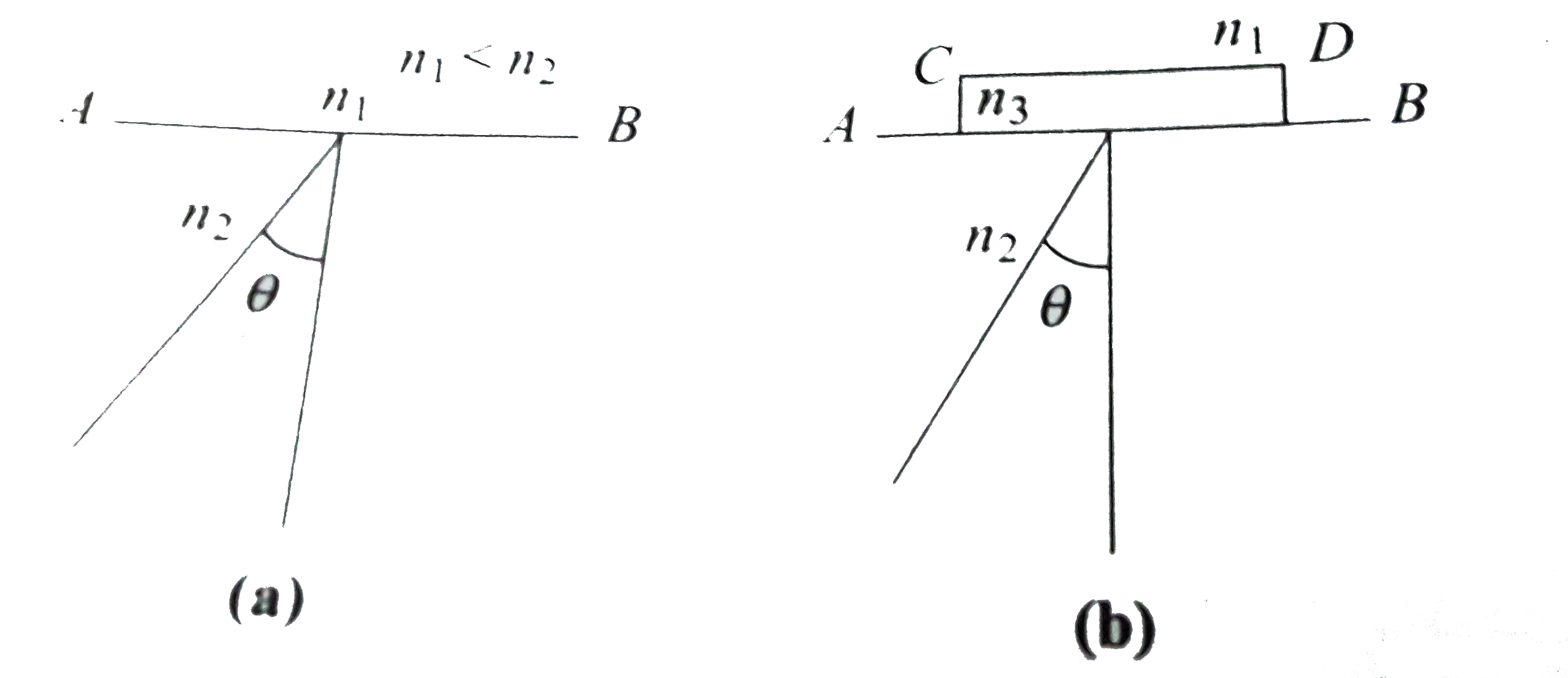In Figure, light is incident at an angle θ which is slightly greater than the critical angle. Now, keeping the incident angle fixed a parallel slab or refractive index n3 is placed on surface AB. Which of the following statements are correct?

Total internal reflection occurs at AB for n3<n1
Total internal reflection occurs at AB for n3>n1
The ray will returen back to the same medium for all values of n3
Total internal reflection occurs at CD for n3<n1
The correct Answer is:a, c.
(a) →n3<n1 so critical angle decreases. Therefore, TIR will take place at AB.
(b) →n3>n1, so critical angle increases. Therefore, TIR will not take place.
(c) →n3>n2, then TIR will take place CD and if n3>n1 , then TIR will take place at AB.
(d) → TIR will not take place at face CD for n3<n1 because ray is going from rarer to denser medium.
Topper's Solved these Questions
- GEOMETRICAL OPTICSBOOK - CENGAGE PHYSICSCHAPTER - GEOMETRICAL OPTICSEXERCISE - Assertion-Reasoninig
2 Videos
- GEOMETRICAL OPTICSBOOK - CENGAGE PHYSICSCHAPTER - GEOMETRICAL OPTICSEXERCISE - Linked Comprehension
51 Videos
- GEOMETRICAL OPTICSBOOK - CENGAGE PHYSICSCHAPTER - GEOMETRICAL OPTICSEXERCISE - Subjective
26 Videos
- FRICTIONBOOK - CENGAGE PHYSICSCHAPTER - FRICTIONEXERCISE - QUESTION BANK
1 Videos
- GRAVITATIONBOOK - CENGAGE PHYSICSCHAPTER - GRAVITATIONEXERCISE - Question Bank
39 Videos
Similar Questions
A monochromatic light is incident on the plane interface AB between two media of refractive indices μ1 and (μ2>μ1) at an angle of incidence θ as shown in Fig.
The angle θ is infinitesimally greater than the critical angle for the two media so that total internal reflection takes place. Now, if a transparent slab DEFG of uniform thickness and of refractive index μ3 is introduced on the interface (as shown in the figure), show that for any value of μ3 all light will ultimately be reflected back into medium II.

View SolutionWhen sun light is incident at an angle of 53∘ on the surface of water, the reflected light is plane polarized. Calculate the angle of refraction and refractive index of water.
View Solution
Knowledge Check
In the figure (a) the light is incident at an angle θ (slightly greater than the critical angle). Now keeping the incident ray fixed a parallel slab of refractive index n3 is placed on surface AB.(fig b)
 Atotal internal reflection occurs at AB for n3=n2Btotal internal reflection occurs at AB for n3>n1Cthe ray will return back to the same medium for alll values of n3Dtotal reflection occurs at CD for n3<n1
Atotal internal reflection occurs at AB for n3=n2Btotal internal reflection occurs at AB for n3>n1Cthe ray will return back to the same medium for alll values of n3Dtotal reflection occurs at CD for n3<n1A ray of light travelling in water is incident on its surface open to air. The angle of incidence is θ, which is less than the critical angle. Then there will be
AOnly a reflected ray and no refrcted rayBOnly a refracted ray and no reflectedCA reflected raya and a refractedray and the angle between them would be less than180∘−2θDA reflected ray and refracted ray and the angle between them would be greater than 180∘−2θA light ray is incident at an angle 45∘ on parallel sided glass slab and emerges out grazing the vertical surface. The refractive index of the slab is
A√32B√52C√32D√52
The critical angle of incidence in a glass slab placed in air is 45∘. What will be be the critical angle when the glass slab is immersed in water of refractive index 1.33 ?
View SolutionA ray OP of monochromatic light is incident on the face AB of prism ABCD mear vertex B at an incident angle of 60degree (see figure). If the refractive index of the material of the prism is √3, which of the following is (are) are correct?

View SolutionIn the diagram shown, light is incident on the interface between media 1 (refractive index n1) and 2 (refractive index n2) at angle slightly greater than the critical angle, and is totally reflected. The light is then also totally reflected at the interface between media 1 and 3 (refractive index n3), after which it travels in a direction opposite to its initial direction, The media must have a refractive indices such that.
 .
.
View SolutionUnpolarised light is incident from air on a plane surface of a meterial of refractive index 'μ'. At a particular angle of incidence 'I', it is found that the reflected and refracted rays are perpendicular to each other.
Which of the following options is correct for this situation?
View SolutionA ray of light travelling in water is incident on its surface open to air. The angle of incidence is θ, which is less than the critical angle. Then there will be
View Solution
